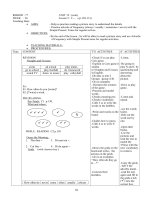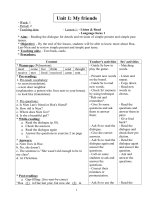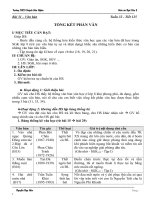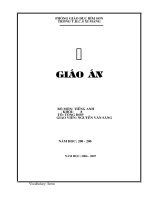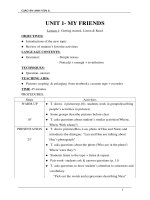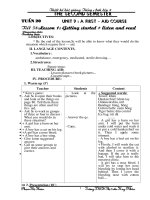giáo án anh văn 8 HKI
Bạn đang xem bản rút gọn của tài liệu. Xem và tải ngay bản đầy đủ của tài liệu tại đây (551.96 KB, 183 trang )
GIAÙO AÙN ANH VAÊN 8
UNIT 1- MY FRIENDS
Lesson 1- Getting started, Listen & Read
OBJECTIVES:
♦ Introductions of the new topic
♦ Review of student’s favorite activities
LANGUAGE CONTENTS:
♦ Grammar: - Simple tenses
- Not(adj) + enough + to-infinitive
TECHNIQUES:
♦ Question- answer
TEACHING AIDS:
♦ Pictures (copiing & enlarging from textbook), cassette tape + recorder
TIME-45 minutes
PROCEDURES:
Steps Activities
WARM-UP
10’
♦ T. shows 4 pictures(p.10)- students work in group(describing
people’s activities in pictures)
♦ Some groups describe pictures before class
♦ T. asks questions about student’s similar activities(Where,
When, With whom?)
PRESENTATION
23’
♦ T. shows pictures(Hoa, Lan, photo of Hoa and Nien) and
introduces the dialogue: “Lan and Hoa are talking about
Hoa’s photograph”
♦ T. asks questions about the photo (Who are in the photo?,
Where were they?)
♦ Students listen to the tape + listen & repeat.
♦ Pair work- students ask & answer questions (p. 11)
♦ T. asks questions to draw student’s attention to structures and
vocabulary.
“Pick out the words and expressions describing Nien“
1
GIAÙO AÙN ANH VAÊN 8
→ What does she look like? - Beautiful
→ What is her smile like? - Lovely
→ How old is she? - 12 (years old)
→ She wasn’t old enough to be in Hoa’s class. T. briefly
explains the meaning of the structure.
♦ Some pairs perform before class.
♦ Some pairs say the dialogue aloud.
CONSOLIDATION
10’
♦ Pair work- students describe the picture (p.10)
♦ T. asks about Nien home town/ appearance/ age
HOME WORK:(2’)
♦ Students find about photo (about people) and describe the person in the
photo, using words and expression already learnt in Tieng Anh 6.7.
♦ Students bring their photos to class (preparing for speaking pratice in
lesson 2)
2
GIAÙO AÙN ANH VAÊN 8
Unit 1- MY FRIENDS
Lesson 2- Speak & Listen
OBJECTIVES:
By the end of the lesson, students will:
♦ Be able to describe people’s appearance, using descriptive adjs.
♦ Develop speaking and listening skills.
LANGUAGE CONTENTS:
♦ Grammar: - descriptive adjectives (about body build, hair)
-Simple tense of HAVE (to describe people)
♦ Language functions: -expressions used in greeting and introduction
TECHNIQUES:
♦ Question-answer
TEACHING AIDS:
♦ Pictures (copying & enlarging from textbook), cassette tape + recorder
TIME-45 minutes
PROCEDURES: Speak (28 minutes)
Steps Activities
Warm-up
4’
♦ T. shows pictures of some people- asking some questions.
What are they? What are they like/What do they look like?
Describe their hair.- reviewing some adjs. Already learnt in TA 6
(tall, short, thin, fat, long, black..)
♦ T. asks students to complete the network of adjectives.
Presentation
6’
♦ T. tells Ss that they will learn more adj to describe people.
♦ T. calls some Ss (having the physical features similar to those
given in the boxes) to the front of the class- teaching new words:
slim, straight/curly/blond (hair) & the use of HAVE
♦ T. asks Ss to look at 6 pictures in the text box and use the adjs,
given in the boxes & the verb HAVE to describe them.
Practice (1)
♦ Ss read the mini- dialogue.
3
GIAÙO AÙN ANH VAÊN 8
12’
♦ Pair work- One student chooses 1 picture and describes that
person; the other guesses who s/he is.
(2)
♦ T. shows 3 or 4 pictures of famous people. Some pairs of Ss
practice the dialogue with these pictures. OR: T. asks Ss to show
the photos they brought to class (homework of lesson 1)- Ss
practice describing people in the photos.
Consolidation
5’
♦ T. calls one student to describe another student in class; other Ss
guess who that person is.
Example: This person is very short and fat. She has curly short hair.
♦ T. review the position of descriptive adjectives (when 2 or 3
adjs go before nouns).
4
GIAÙO AÙN ANH VAÊN 8
Listen (17 minutes)
Steps Activities
Pre-listening
6’
♦ T. reviews the expressions for greetings- explaining when to use
them.
♦ Ss read these expressions (p. 12)
♦ Ss read the 4 conversations (pp. 12-13) and try filling in the
blanks.
♦ T. asks Ss to get ready to listen to the tape and check if their
answers(words in the blanks) are correct.
While-listening
4’
♦ Ss listen to the tape (all 4 conversations).
♦ Ss listen again with a pause after each conversation.
Post-listening
7’
♦ T. calls some Ss to give answers- giving correction.
♦ T. picks out some new expressions: The pleasure is all mine;
Hello, ma’am/young man. Explaining when to use these
expressions.
♦ Ss work in groups of 3 or 4 and practice introducing to people.
HOMEWORK:
♦ Write about the people in the photo you brought to class (name, job, body
build, hair).
Example: This person’s name is _________. He is a (doctor). He is
tall and slim. He has curly short black hair.
5
GIAÙO AÙN ANH VAÊN 8
Unit 1- MY FRIENDS
Lesson 3- Read
OBJECTIVES:
By the end of the lesson, students will
♦ Know how to talk about people’s character and their favorite activities.
♦ Develop reading skills
LANGUAGE CONTENTS:
♦ Grammar: -simple tense of be (to describe people)
♦ Vocabulary: -adjective about human character): sociable,
kind, generous, reserved, outgoing
TECHNIQUES:
♦ Question- answer, scanning
TEACHING AIDS:
♦ Worksheets or transparency sheet (for task 2)
TIME-45 minutes
PROCEDURES
Steps Activities
Pro-reading
10’
♦ T. asks question about Ss’ friends: do you have many
friends? What are they like? What do they like doing in
their free time?
♦ T. pre-teaches some key words: character, sociable/ out
going, reserved, generous
♦ T. introduces the new reading text and gives task 1;We’ll
read about Ba’s friends.
♦ TASK 1 : How many does Ba talk about in the text?
While-reading ♦ Silent reading: Ss read the text and do task 1.
Answer 4: people (including himself)
♦ TASK 2 : Read the text and complete the information about
Ba and his friends.
character favorite activities
6
GIAÙO AÙN ANH VAÊN 8
20’
Ba
Bao
Khai
Son
g
Answer:
character Favorite activities
Ba -not as outgoing/sociable
as Bao
-with a sense of humor
-telling jokes
Bao -Sociable, kind, generous,
hard-working
-doing volunteer work
Khai - reserved in public -playing soccer
Son
g
-reserved in public -going the local library
♦ T. asks Ss to pick out verbs used to indicate what people
like doing: spend time doing sth, enjoy, like, prefer
♦ T explains other new words.
♦ TASK 3 : Pair work: Ss do the exercises (1 and 2) in the
book.
♦ Some Ss read the text aloud; some pairs ask and answer
Qs in exercise 2 before class.
Post-reading
12’
♦ Group work’s work in groups of 4 or 5. Each student
describes one friend in the group (character & favorite
activities).
♦ Representatives of some groups describe their group
members. Other Ss guess who they are.
Consolidation
3’
♦ T reviews the use of some verbs describing people’s
favorite activities
HOMEWORK:
7
Spend time + V -ing
Prefer + to -infinitive
Like + N/V -ing Enjoy + N/V -ing
GIAÙO AÙN ANH VAÊN 8
Write some sentences about your close friend or one member in
your family (his/her character & favorite activities).
8
GIAÙO AÙN ANH VAÊN 8
Unit 1-MYFRIENDS
Lesson 4- Write
OBJECTIVES:
By the end of the lesson, students will
♦ Be able to describe themselves or their close friends
♦ Develop writing skills
LANGUAGE CONTENTS:
♦ Grammar: -present tense of verbs (to describe people)-Review
♦ Vocabulary: -adjectives (about human character and
appearance)- Review
TECHNIQUES;
♦ Question-answer, information completion, transferring information
TEACHING AIDS;
♦ Word cards (adjs describing body build, hair, character), worksheets (same
form as exercise 1 in textbook), transparency sheet (copy of information
about Tam)
TIME- 45 minutes
PROCEDURES:
Steps Activities
Pre-writing ♦ Warm-up: T. asks Ss to put 10 word cards in the correct
columns (under appearance & character).
Appearance Character
Tall Generous
Slim Outgoing
Curly Sociable
Straight Reserved
Brown Sense of humor
♦ T.shows the transparency sheet. T. asks Ss to read the
passage and tell where the information in the passage is
taken from. Example: The first sentences is from N
0
(1), the
2
nd
sentence is from N
0
(4)…
Information about Tam
9
GIAÙO AÙN ANH VAÊN 8
20’
(1) Name: Le Van Tam Age:14
(2) Description: tall, thin, short black hair
(3) Character: sociable, humorous, helpful
(4) Address: 26 Tran Phu Street, Ha noi
(5) Family: mother, father, elder brother-Hung
(6) Friends: Ba, Bao
♦ Pair work-Ss ask and answer Qs (exercise 2) to complete
the worksheets with information about their partners.
Information about
(1) Name: Age:
(2) Description:
(3) Character:
(4) Address:
(5) Family:
(6) Friends:
While-writing
15’
♦ Ss use the information in the worksheets to write about
their partners.
♦ Ss in each pair compare their descriptions.
Post-writing
10’
♦ Some Ss read aloud their descriptions.
♦ T. corrects errors and gives comments
……
HOMEWORK:
Write a paragraph about one of your family members.
10
GIAÙO AÙN ANH VAÊN 8
Unit 2-MAKING ARRANGEMENTS
Lesson1-Getting started, Listen & Read
OBJECTIVES:
♦ Introductions of the new topic
♦ Making arrangements on telephone
LANGUAGE CONTENTS:
♦ Grammar:
-Be going to + verb (talking about intentions)
-Adverbs of place (location of thing or people)
♦ Vocabulary:
-Fax machine, address book, telephone directory, public telephone,
mobile phone and answering machine.
TECHNIQUES:
♦ Question-answer, information completion, transferring information
TEACHING AIDS:
♦ Picture (copied and enlarged from textbooks), real objects, cassette tape +
recorder.
TIME-45 minutes
PROCEDURES:
STEPS ACTIVITIES
Warm-up
10’
- Teacher shows 6 pictures or word cards (page 18)- two real
things (mobile phone, telephone directory)- students work in
groups
- Teacher asks questions
1. What is this? (mobile phone)
2. When do you use it? (to make a phone call)
3. What is this? (a telephone directory)
4. When do you use it? (to find the telephone numbers of
someone)
- Teacher asks about students’ activities
11
GIAÙO AÙN ANH VAÊN 8
• An answering machine (to record telephone messages
from people ring you when you are out)
• A fax machine (to copy an exact picture, letter…)
• A public telephone (to make a phone call when you are
on the sidewalk)
• An address book (book that is used to write down the
address of someone)
- Teacher asks students to work in pairs and fix the word
cards to suitable pictures
- Teacher asks students to read the new words again
(emphasizes the pronunciation of the words “
machine” /mə∫in/, mobile /moubəl-bai/)
- Teacher asks more questions
1. Do you have an address book?
2. Does your father (mother) have a mobile phone?
3. Is it helpful if you have one?
4. Which of theses things do you want to have? (Students
choose one of them)…
Presentation
23’
1. Teacher shows pictures(photo of Hoa and Nga) and
introduces the dialogue:
“This is Nga. She is making a call to invite Hoa to see a
movie with her. The name of the movie is” Dream City”. It
begins at 6:45 at Sao Mai movie theater. Hoa can go and
they are going to meet outside the theater at 6:30”
2. T. asks questions:
a) Who made the call, Hoa or Nga? Nga
b) What’s the name of the movie? Dream City
c) What time does the movie begin? At 6:45
d) Who does she want to go with? Hoa
e) Where do they meet? Outside the theater
f) What time? At 6:30
12
GIAÙO AÙN ANH VAÊN 8
g) Who arranged the meeting place? Nga
h) Who arranged the time? Hoa
i) Who agreed the time? Nga
3. Students listening the tape- listen & repeat (twice)
4. Teacher asks students to answer the questions above.
5. Some pairs perform before class.
6. Some pairs say the dialogue aloud
7. T. remind students to use the present continuous to show
the intentions in the future(in Vietnamese)
Consolidation
10’
- Pair work:
• Students say the dialogue
• Students practice asking and answering the question
(page 19)
• Make a dialogue with these cues (Nam and Ba/Rex
cinema/Spiderman/7:00/Outside the theater at 6:45)
Homework
2’
- Students do the exercise 4(on page 17) in workbook
- Learn by heart the new words on page 18
13
GIAÙO AÙN ANH VAÊN 8
UNIT 2 : MAKING ARRANGEMENTS
lesson 2: speak, listen
OBJECTIVES:
• Practice of developing speaking and listening skills about making
arrangements on telephone.
LANGUAGE CONTENTS:
• Vocabulary: Concert (n), band (n), start (v), inside, outside (adv)
• Expressions: Great, me too
I’m sorry, I can’t
TECHNIQUES: Pre-reading and prediction
TEACHING AIDS: Pictures (copied and enlarged from textbook), cassette
tape + recorder.
TIME-45 minutes
PROCEDURES: Speak (28 minutes)
Steps Activities
Warm-up
4’
- T. shows pictures of some people- asking some questions
Who are they? What is Adam going to do? What’s this?
Will they go to the concert?
• Key answers: -They are Adam and Eric. He’s going to
phone Eric.
- It’s a band. Yes, they will.
Presentation
6’
- T. tells Ss to read the sentences and guess who are talking
on the phone and what for
- Tasks Ss to look at the pictures and guess the order of the
sentences
Practice
12’
(1)
- Tasks Ss to read and make a complete conversation
(individual or pair)
- T. checks and corrects
- T. asks Ss to write the correct conversation, practise in
pairs.
14
GIAÙO AÙN ANH VAÊN 8
(2)
- Teacher tells Ss to read the open dialogue. (introduce:Bao
invites Ba to play chess)
- Ss practise in pairs (they themselves fill in the open
sentences)
- T. asks Ss to play the dialogue(some pairs)
- T. corrects the mistakes in pronunciation
Consolidation
5’
- T. asks Ss to enlarge the dialogue(making new dialogues
based on the model one).
Listening (17 minutes)
Steps Activities
Pre-listening
6’
- T. introduces secretary, woman and Mrs. Mary Nguyen in
the dialogue and the purpose of the exercises.
- T. asks Ss to read to read the message form. Explain the
information on it
While-listening
4’
- T. tells Ss to listen to the tape and fill the information into
the message from.
Post-listening
7’
- T. asks Ss to listen on the conversation (the last time) to
check the answers.
- T corrects the mistakes.
Homework: -Ss listen to the conversation again and do the similar dialogues
-Prepare lesson write.
15
GIAÙO AÙN ANH VAÊN 8
UNIT 2-MAKING ARRANGEMENTS
Lesson 3-Read (p.21)
OBJECTIVES:
By the end of the lesson, students know who is the inventor of telephone and
develop reading skills.
LANGUAGE CONTENTS:
• Grammar: simple past tense, neither-nor
• Vocab : (v) emigrate, transmit, conduct, demonstrate
(n) deaf-mutes, device, exhibition, assistant.
(a) countless, commercial
TECHNIQUES:
• Pre questions-Predict
• Scanning reading
TEACHING AIDS:
Worksheets (same form as ex 1 in textbook)
TIME-45 minutes
PROCEDURES:
Steps Activities
Pre-reading (10’) T. asks Ss to think of the answers for the following
questions
1/ Who invented the telephone?
2/ What’s his nationality?
3/ When did he invent the telephone?
T. pre-teaches some key words.
(v) emigrate, transmit, conduct, demonstrate
(n) deaf-mutes, device, exhibition, assistant
(a) countless, commercial
T. introduces the new reading text and gives task 1: We’ll
read about the inventor of the telephone.
TASK 1: Who invented the telephone? When did he invent
16
GIAÙO AÙN ANH VAÊN 8
it?
While-reading (20’) Silent reading: Ss read the text and check their predictions.
Answer key:
1/ Alexander Graham Bell invented the telephone.
2/ He was a Scotsman.
3/ He invented it in 1876.
TASK 2: Ss read the text again and do the exercises (1 and
2) in the book. (work in pairs)
T. invites some students to give their answers and check
which answer is right.
Post-reading (12’) • Group work: Ss work in group of 4 or 5. Each student
states one sentence about Alexander Graham Bell
• Representatives of some groups retell the text in their
own words
Consolidation (3’) • T. takes note the structure: neither-nor
• T. reviews the simple past tense
HOMWORK: Write 5 sentences about the inventor of the telephone
17
GIAÙO AÙN ANH VAÊN 8
Unit 2-MAKING ARRANGEMENTS
LESSON 4-WRITE
OBJECTIVES:
By the end of the lesson, students will:
• Be able to describe about their intentions
• Develop writing skills
LANGUAGE CONTENTS:
• Grammar: Near future (going to talk about intentions)
• Vocab : Write the telephone message, explain some new words,
furniture delivery stationary order.
TECHING AIDS:
• Worksheets (same form as exercise 1, 2) transparency sheet (copy of
information about someone) real objects: telephone.
TIME-45 minutes
PROCEDURES:
Steps Activities
Pre-writing (20’) • Warm-up: T. asks Ss to read the information in the
telephone message.
• T. explains new word: furniture delivery.
• T. shows the transparency sheet. T. asks Ss to fill in the
gaps in the passage that follows with the information.
• T. asks Ss to read the whole passage.
• T. corrects errors and gives comments.
1/ (tele)phon
e
2/ May 12 3/ speak 4/ took
5/ name 6/ delivery 7/ Ms.Ha 8/ at
While-writing (15’) • T. asks Ss to read silently the information about the
telephone message in the passage.
• T. explains the new word: stationery order.
• Ss use the information in the passage to write the telephone
message in the worksheets.
18
GIAÙO AÙN ANH VAÊN 8
• Ss in each pair compare their message.
• T. checks the answers.
• T. corrects errors and gives comments.
THANH CONG Delivery Service.
Date :June 16
Time :After midday
For :Mrs. Van
Message: Mr. Nam called about his stationary order. He
wanted you to call him at 8 634 082.
Taken by: Mr. Toan
Post-writing (10’) • T. asks Ss to read the message from on page 23 again.
• Ss read the dialogue silently.
• T asks Ss some questions about the information the
dialogue.
1/ Who leaves the message?
2/ Who does Tom leave the message for?
3/ Who is taken the message by?
4/ What is the message about?
• Some Ss read their worksheet; they can compare their
message. T. corrects errors to help Lisa write a message for
Nancy.
Date :………………(Ss write)
Time :………………(Ss write)
For : Nancy
Message: Tom called about playing tennis this afternoon. He
will come to pick you at 1:30.
Taken by: Lisa.
HOMEWORK:
1. Write the telephone message (for your parents)
2. Write a paragraph about the telephone message (for your friend)
19
GIAÙO AÙN ANH VAÊN 8
LESSON PLAN
UNIT TWO: MAKING ARRANGEMENTS
LESSON 5: LANGUAGE FOCUS
A. OBJECTIVES :
Master the grammar points and vocabulary in Unit two
+ Students can talk about their intentions with<<Be going to>>
+ Pupils can use adverbs of place in daily communication
B. LANGUAGE CONTENTS:
+ Future tense: Be going to + verb
+ Adverbs of place: outside, inside, upstairs, downstairs
C. TECHNIQUES :
+ Communicate approach
+ Questions-Answers
+ Gap-Fill
+ Check ()-Cross (x)
D. TEACHING AIDS:
+ Pictures (copied from text book)
+ Real objects
E. PROCEDURES
Steps Activities
Warm up (10’)
New lesson:
Language focus
(23’)
* Teacher asks: What’s the weather like today?
- It’s warm
- It’s sunny
- It’s beautiful
Oh! It’s a beautiful day.
What are you going to do this afternoon?
- I am going to …
1. Now here are some intentions people are going to do,
Please tell your partner what they are going to do.
- Students practice in pairs
20
GIAÙO AÙN ANH VAÊN 8
Consolidations:
(10’)
Formation: S + BE GOING + TO-INF
2. What are you going to do on weekend?
a. Students add three more activities to the list. Then
complete the<<you>> column with checks () or crosses (x)
- Students do in pair work, then compare the answers
- Some students talk about their intentions and their
friends’ intentions before class
- Teacher corrects the mistakes if possible.
b. Students practice in pairs
- They ask their friends about intentions. Then complete
checks () or crosses (x) in partner column
3. Teacher shows the students the pictures and asks them
to fill the blanks with adverbs of place in the box following
the story<<Ba and Tuan are playing hide and seek>>
Pair work and group work “playing hide and seek”,
“inside and outside the door”, “up and down the platform”
Saying about positions of school things
Saying about intentions for tomorrow and this summer
holiday.
HOMEWORK: Do the exercises 3, 5, 7(on page 15, 18, 19)
Learn by heart the information of “Be going to” and “adverbs
of place”
Prepare the new lesson
21
GIAÙO AÙN ANH VAÊN 8
UNIT THREE: AT HOME
LESSON 1: GETTING STARTED & LISTEN AND READ
A. OBJECTIVES :
♦ Introduction of the topic.
♦ Review of the students’ chores at home.
B. LANGUAGE CONTENTS :
♦ Grammar: -Modal verbs (ought to/have to) & reflexive pronouns
♦ Vocabulary: do the washing-up/make the bed/sweep the floor/tidy
up/feed the chickens/yourself.
C. TECHNIQUES:
♦ Role play
♦ Silent reading
♦ Completing the list.
D. TEACHING AIDS:
♦ Pictures. +overhead
♦ A cassette recorder and tape. +Transparency sheet
♦ Word cards.
E. TIME : 45 minutes
F. PROCEDURES :
Steps Activities
1. Warm –up: 10’ - T. elicits by using some questions.
- Play a game. (Asking 4 Ss to write their chores on the
board. Then comparing their sentences with the pictures).
- T. introduces the new words(using the word cards).
- T. asks Ss to practice with a partner.
2. Presentation: 27’ - Lead-in : T. asks Ss to answer some questions about their
chores (using the new words). Examples: What do you have
to do at home? /Do you have to make the bed?
- T. gives guiding- questions.(Does Nam have to cook
dinner?/What does he have to buy at the market?)
- T. shows the picture to introduces the dialogue. Then asks
22
GIAÙO AÙN ANH VAÊN 8
Ss to answer the guiding-questions.
- T. has Ss listen to the cassette tape.
- Ss listen and repeat.
- Pair-work: Ss practice the dialogue in pairs.
- Ss read the dialogue silently. Then check their answers.
- T. provides the correct answers.
- T. has Ss read the dialogue again and complete the list.
- T. make a model.
- Group work: Ss complete the list.
- T. corrects their answers.
- T. asks Ss to draw Ss’ attention to the structures.(Have
to/ought to/reflexive pronouns).
+ Nam has to cook dinner himself.
+ He ought to go to the market himself.
(T. briefly explains the meanings of the structures).
3. Consolidation: 5’ - T. asks Ss to reproduce language knowledge with the
pictures.
- Pair work-Ss ask & answer questions about their
housework.
4. Homework: 3’ - Write 5 sentences about your housework using “ought
to/have to”
- Review words of household appliances.
G. EVALUATION :
23
GIAÙO AÙN ANH VAÊN 8
UNIT 3: AT HOME
Lesson 2: Speak
OBJECTIVES :
By the end of the lesson, students will:
• Be able to describe position of each item, using prepositions.
• Developing speaking skill-description of a room
LANGUAGE CONTENTS:
• Grammar:
- Simple present tense.
- Prepositions (between, under, in, next to, above,)
• Language functions:
- Prepositional phrase used to describe positions of furniture.
TECHNIQUES:
• Question-answer
TEACHING AIDS :
• Pictures (copying & enlarging from the textbook), a cassette tape +
recorder
TIME-45 minutes:
PROCEDURES Speak (45 minutes)
Steps Activities
Warm-up
5ms
T. shows pictures:
- Speaking two model sentences in the text book
1. The fruit is in the bowl
2. The plate is on the table
- Reviewing some prepositions already learnt in TA
6{between, on, in, next to…}
Presentation T. shows pictures:
- Asking students to work in pairs talk about the position of
item in pictures.
24
GIAÙO AÙN ANH VAÊN 8
10ms
T. calls some students to describe the position of furniture.
- Using: Let’s + infinitive, ought to, should.
T. corrects.
Practice
20ms
T. introduces pictures:
- Asking students to work in pairs or in groups to arrange the
furniture in the room that must roach an agreement.
- Using: Let’s + infinitive, ought to, should.
T. corrects.
Consolidation
5ms
T. calls one or two students to describe position of furniture in
class room.
HOMEWORK:
Write about the position of furniture in your house.
25


